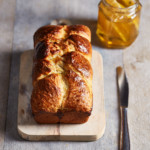Sourdough Brioche Recipe
Have you ever wondered if you can make brioche with a sourdough starter? The answer is yes, you can. This sourdough brioche is mild-tangy and not too sour thanks to the moderate addition of sourdough starter and a shorter fermentation time. It rises naturally without the use of commercial yeast. It's a delicious treat and perfect for breakfast, brunch, or making French toast.
Servings: 8 servings
Calories: 272kcal
Ingredients
Leaven* (see note)
- 10 g sourdough starter
- 50 g bottled or filtered water
- 50 g bread flour
Dough
- 250 g bread flour
- 30 g sugar
- 5 g salt
- 2 large eggs, at room temperature
- 55-60 g milk, at room temperature (use enough milk so that the eggs and milk weigh a total of 175 g)
- 80 g leaven
- 110 g unsalted butter, at room temperature
For baking
- egg wash (1 egg + 1 tablespoon water or milk)
- Optional crushed nib sugar
Instructions
Prepare the leaven
- Combine the sourdough starter, water, and flour and stir until no lumps remain. Let sit in a warm spot (68-75°F / 20-24°C) until it has risen by about 75% and passes the float test, about 4-6 hours.
Prepare the dough
- In a large bowl, using an electric mixer fitted with a hook attachment, add the flour, sugar, salt, eggs, milk, and leaven and knead on low speed until it comes together about 3-4 minutes. Scrape down the sides of the bowl halfway through. Let rest for 20-30 minutes.
- Then knead on high speed for about 6-8 minutes until the dough releases from the sides of the bowl and passes the windowpane test. Reduce the speed to medium-low and gradually add the butter and knead until the butter is fully incorporated. Once all of the butter has been incorporated, increase the speed to high and knead until the dough is smooth and releases from the sides of the bowl. It's a very soft and smooth dough that is slightly tacky to the touch.
- Lightly spray a straight-sided container with oil and transfer the dough to the container; lightly oil the top of the dough as well. Cover and let rest in a warm spot (70-77°F / 21-25°C) until doubled in size, about 12-24 hours.
Prepare the loaf
- Carefully remove the dough from the container with a dough scraper and place it on a work surface. Shape the dough into a round ball with as few moves as possible. This works best with a bench knife in a rotary motion. Let rest for 15-20 minutes.
- Grease an 8x4-inch (20x10cm) loaf pan or a 6-inch (15cm) round/square pan with butter and set aside.
- Divide the dough into 8 equal pieces. Gently cup one dough portion with one hand and form a C shape with your hand. Move the dough with your hand in a circular motion and press it gently against the work surface to build tension, stretch the surface of the dough, and close the seams at the bottom. If the dough is a bit sticky, oil your hands very lightly. Avoid using flour on the work surface so that the dough can anchor to the surface while you move. Do this gently without deflating the dough, and don’t overwork the dough.
- Arrange the dough balls in the prepared pan. Lightly oil your fingers to prevent the balls from sticking to your fingers when you arrange the balls in the pan. In the loaf pan, I usually place two balls next to each other and make 4 rows. Cover and let rest for 1-2 hours at room temperature and then place in the refrigerator for 30 minutes or up to 12 hours. It doesn't double or grow significantly during the second rise as the butter firms up in the refrigerator and prevents the dough from growing in size.
- Preheat the oven to 485°F (252°C) for 20 minutes.
- Remove the dough from the fridge, brush with egg wash, and sprinkle with crushed nib sugar if desired. Transfer the loaf to the oven and immediately turn the heat down to 400°F (204°C) and bake for about 35 minutes until the crust is golden brown, and it makes a hollow sound when knocking on the bottom of the bread. After 20 minutes, cover it loosely with aluminum foil to avoid heavy browning if necessary.
- Remove from the pan, transfer to a cooling rack, and let cool completely. Slice and enjoy.
Video
Notes
* I feed my sourdough starter in a ratio of 1:5:5, 1 part starter, 5 parts flour, and 5 parts water and it doubles in 4-6 hours. If you feed your starter in a different ratio (1:1:1 for example), I recommend preparing the leaven in the ratio you would normally feed your starter. It has to be strong enough to double in 4-6 hours. Otherwise, the leaven may not grow as expected and the loaf may not rise properly.
Nutrition
Calories: 272kcal | Carbohydrates: 32g | Protein: 6g | Fat: 13g | Saturated Fat: 8g | Polyunsaturated Fat: 1g | Monounsaturated Fat: 3g | Trans Fat: 1g | Cholesterol: 77mg | Sodium: 266mg | Potassium: 67mg | Fiber: 1g | Sugar: 4g | Vitamin A: 423IU | Calcium: 24mg | Iron: 1mg
